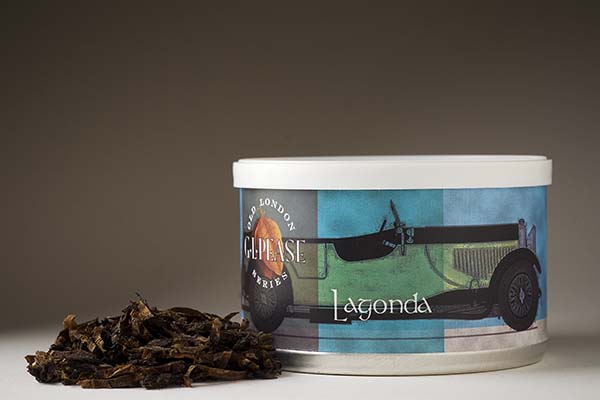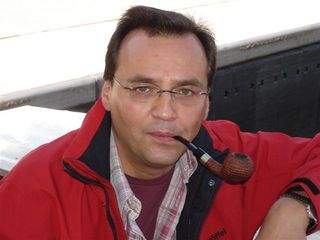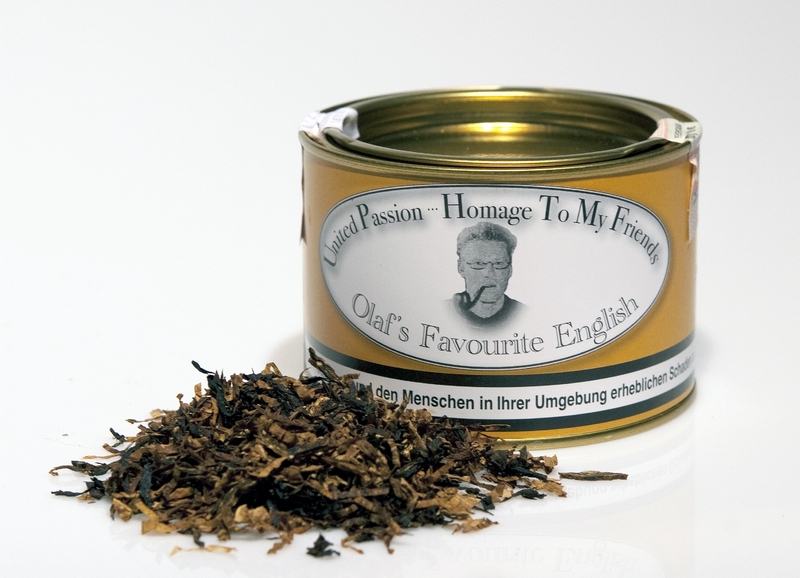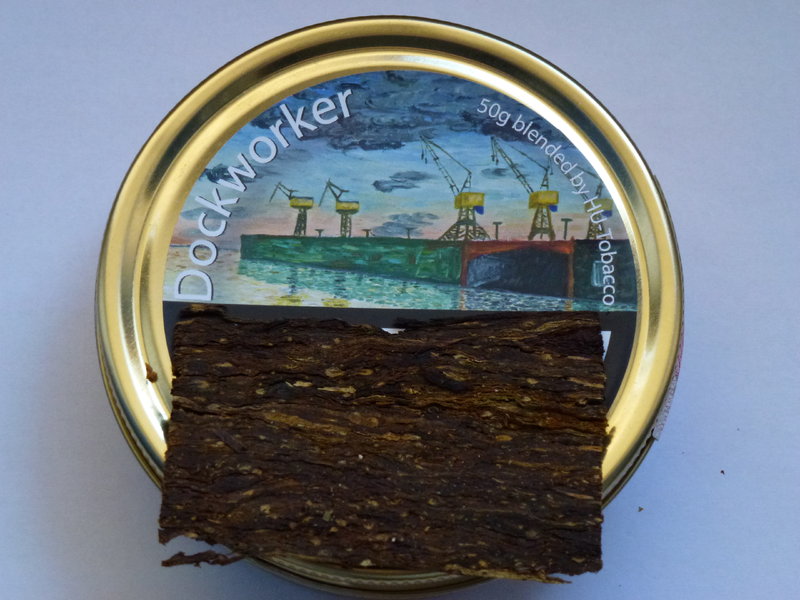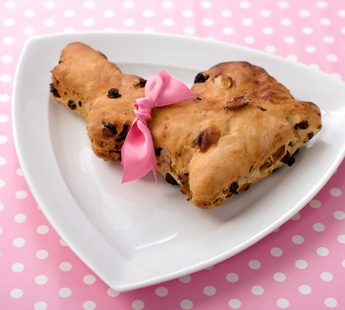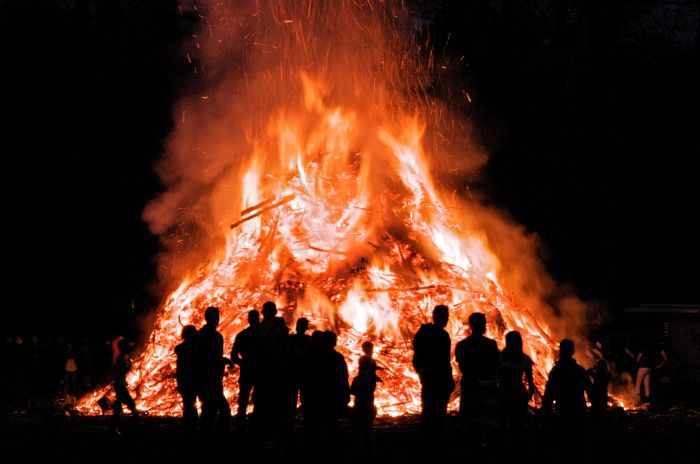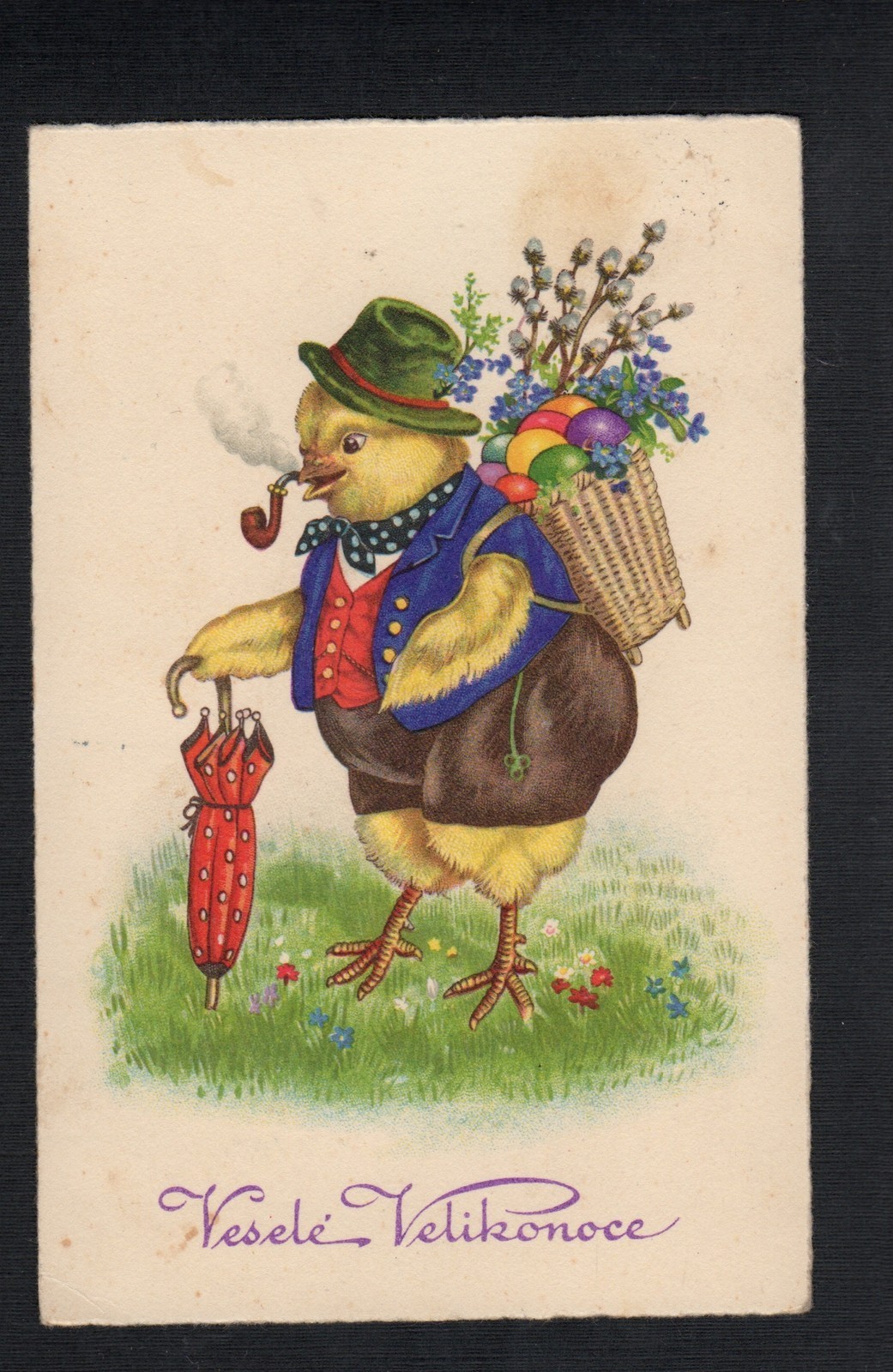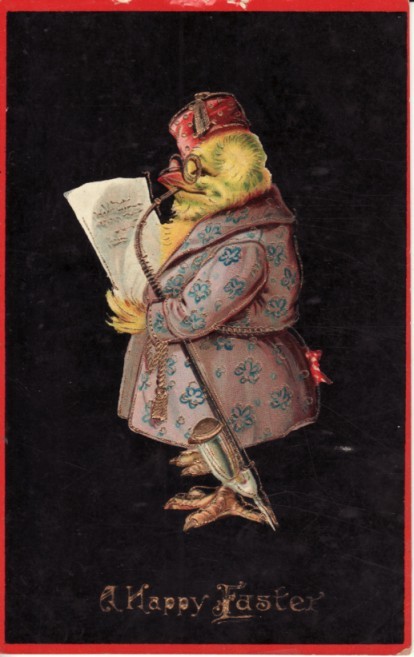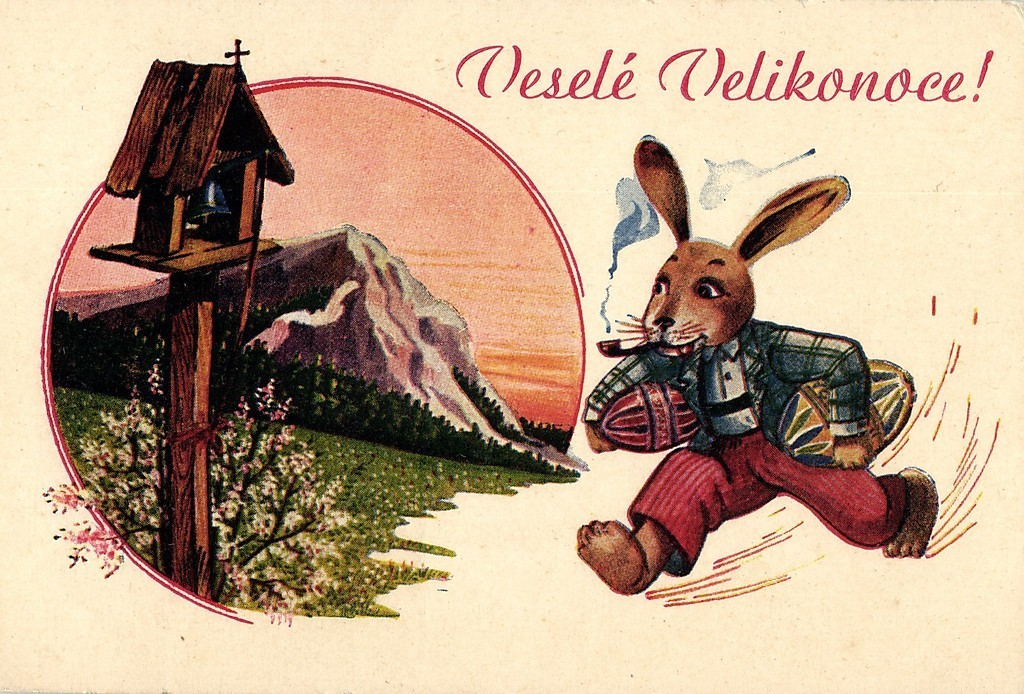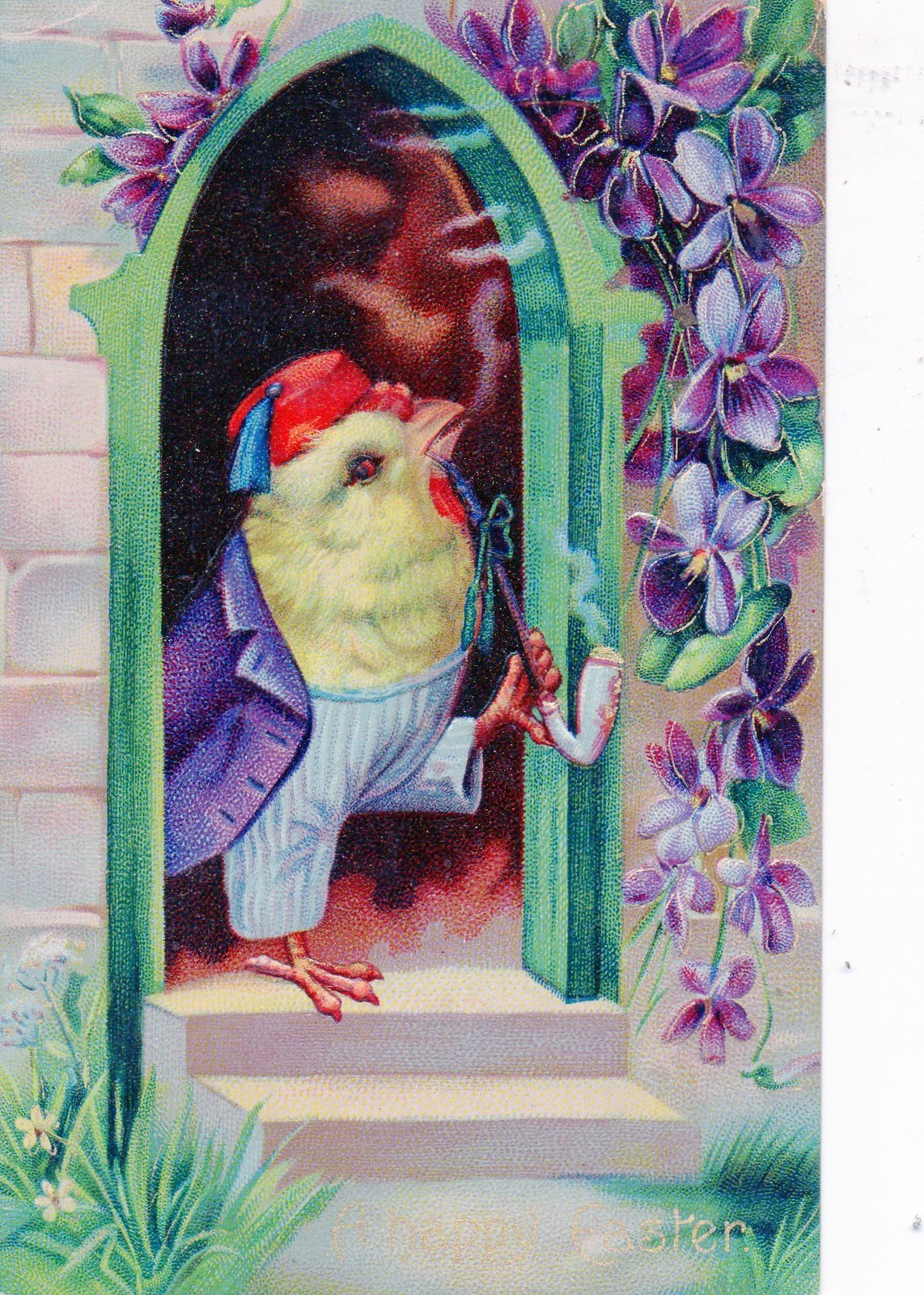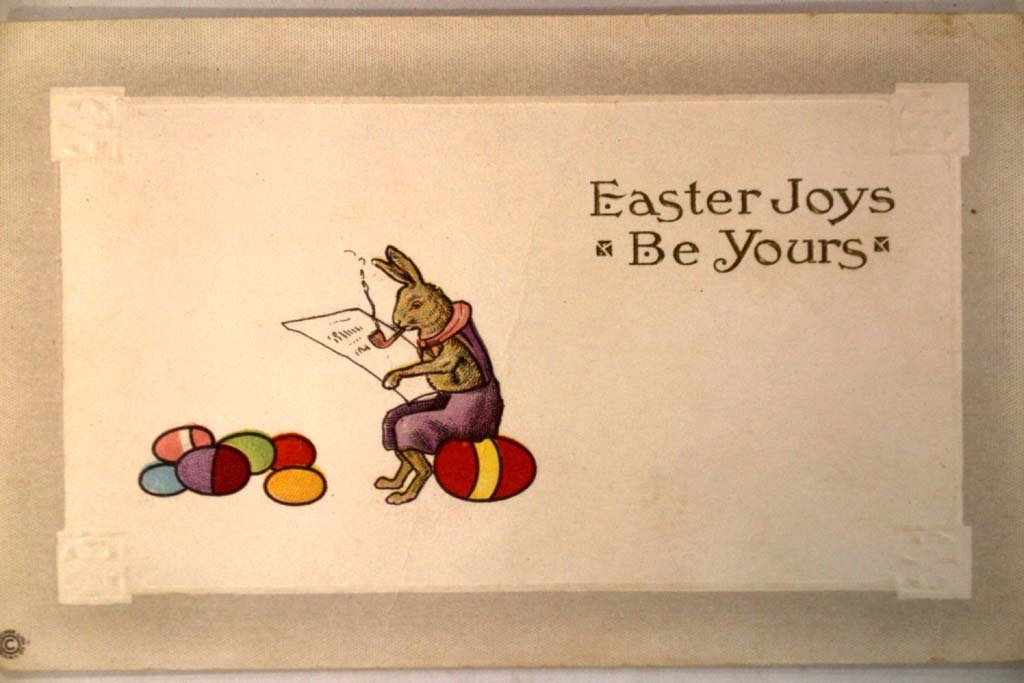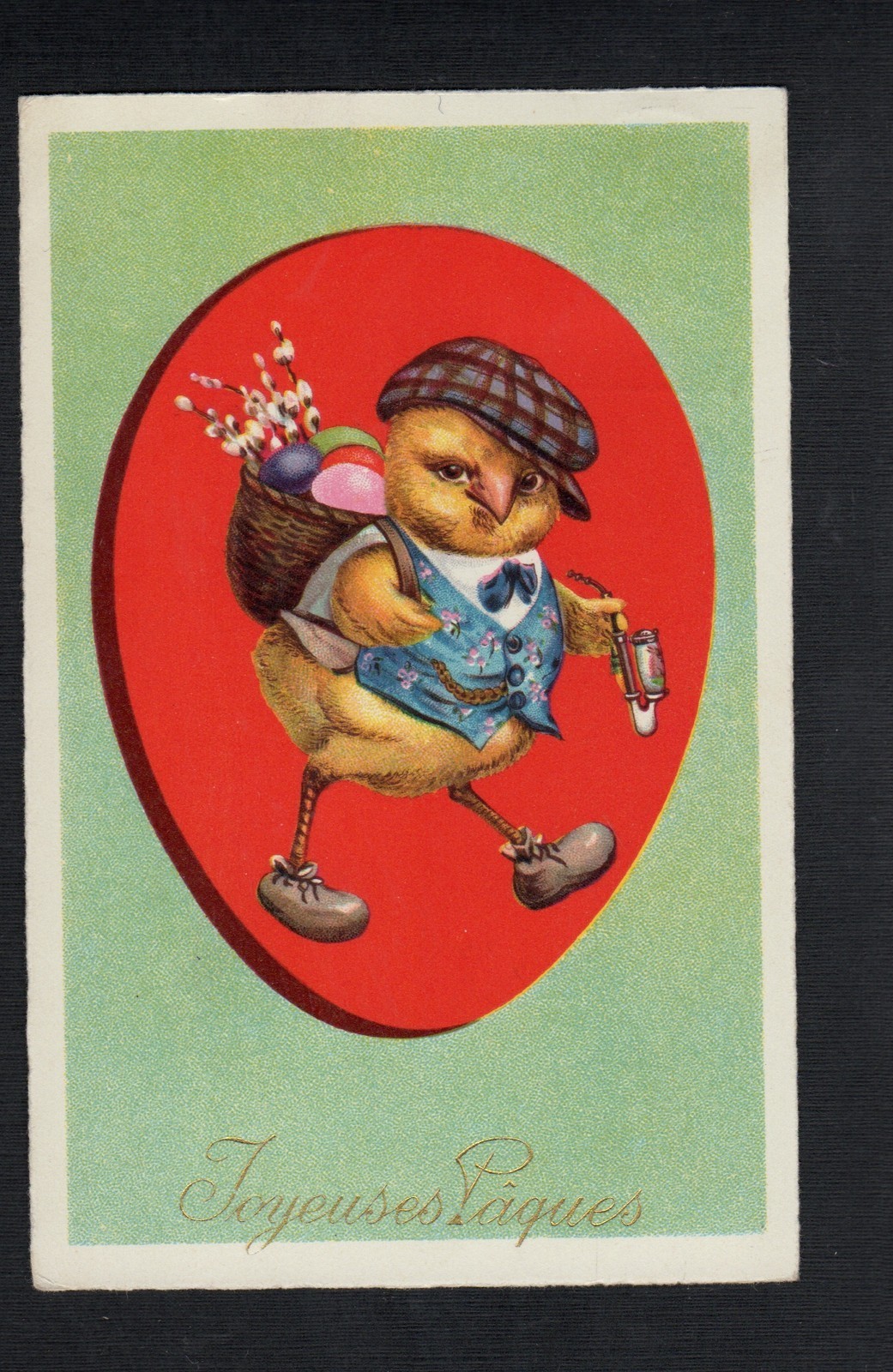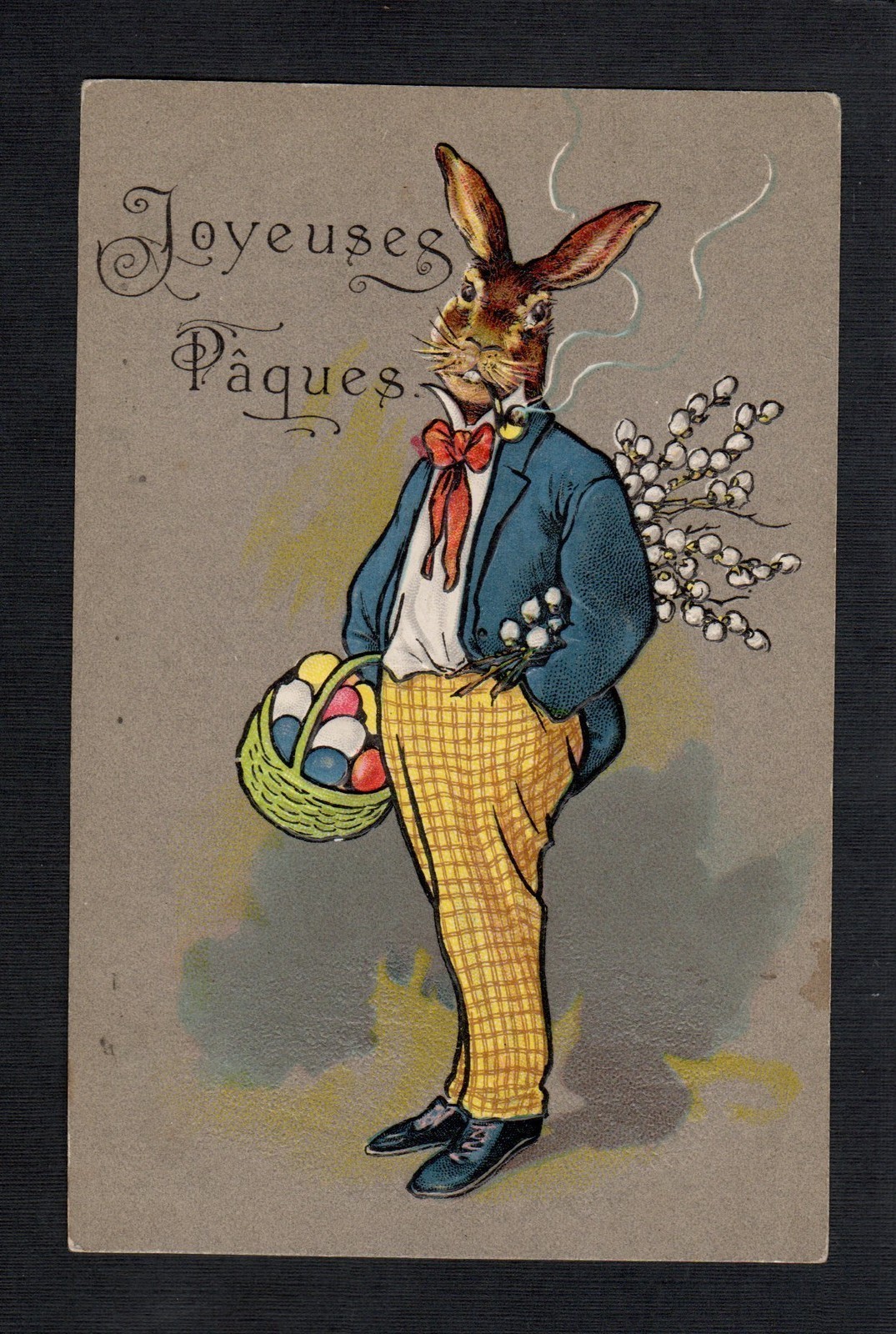 Also see this post: Smokin’ Easter
Also see this post: Smokin’ Easter
Tag Archives: tobacco pipe
The McLardy bulldog
As a lover of history I browse through e-bay searching for antique pipes once in a while. I very much like the thrill of owning and smoking a 100+ year old pipe, I see it as some sort of time machine. While enjoying such a smoke my mind drifts off and I think about how the world looked like when the pipe was made, who the previous owners were and what stories it could tell if it could speak. So on one of my searches I stumbled upon a gorgeous antique bulldog shaped pipe with a beautifully decorated silver rim and ring in almost pristine condition. Unfortunately the mouthpiece was missing. Probably it was made from amber and had broken a long time ago. Despite that I decided to bid on the pipe and to my delight I won! I asked Frisian pipe-maker Meindert if he could clean up the antique bulldog and make a new mouthpiece for it. He rose up to the challenge.
 In the meanwhile I looked up the silver-marks because I wanted to be sure of the production year and the company who made it. Dating the pipe proved to be simple, Birmingham marks from the year 1890! Holy crap, 125 years old! 1890.. The Sleeping Beauty ballet with music by Tchaikovsky was premièred, the second Sherlock Holmes novel (The Sign of the Four) was published, famous Dutch painter Vincent van Gogh died, The Picture of Dorian Gray by Oscar Wilde was published, American writer H.P. Lovecraft was born and the folding carton box we all know today was invented by Robert Gair. However, the maker of the antique bulldog was a bit more difficult to discover. Luckily the triangle logo on the shank with the letters “S Mc L” inside set me on the correct path and soon I found its creator: the Samuel McLardy company from Manchester.
In the meanwhile I looked up the silver-marks because I wanted to be sure of the production year and the company who made it. Dating the pipe proved to be simple, Birmingham marks from the year 1890! Holy crap, 125 years old! 1890.. The Sleeping Beauty ballet with music by Tchaikovsky was premièred, the second Sherlock Holmes novel (The Sign of the Four) was published, famous Dutch painter Vincent van Gogh died, The Picture of Dorian Gray by Oscar Wilde was published, American writer H.P. Lovecraft was born and the folding carton box we all know today was invented by Robert Gair. However, the maker of the antique bulldog was a bit more difficult to discover. Luckily the triangle logo on the shank with the letters “S Mc L” inside set me on the correct path and soon I found its creator: the Samuel McLardy company from Manchester.
The McLardy company thanks its existence to the entrepreneurial spirit of 1 person: Samuel McLardy, born in Glasgow in 1842. He was the son of a tobacconist who also produced his own clay pipes. In the paternal shop he must have learned the profession of pipe-maker. Shortly after his 20th birthday he decided to move to Manchester to start his own company. There is remarkably little known about the history of the factory. On an old advertisement it says “established 1865” so since then there must have been a steady growth. Within a couple of decades there was a massive production of clay pipes. Around 1895 the factory owned over 500 moulds which meant yearly production was around 5 million pipes! Similar to that of Dutch factory P. Goedewaagen & Zoon in that period.
Over time we find Samuel McLardy at different locations. Before 1880 that was Miller Street number 16 in Manchester and it is there where the shop grew to the size of a factory. In 1890 the company moved to Shudehill number 67 where it remained active until after 1910. At the new address they occupied an imposing factory building that you can see on the cover of an old catalogue beside this text. Such factory-illustrations have to be taken with a grain of salt, because often they are grossly exaggerated. The building had a high façade that could accommodate show rooms and an office and there were 4 floors for production and storage. After WWI we find McLardy headquarters in Swan Buildings at number 20 of the Swan Street but they also had several workshops at other addresses and that was certainly true for the pipe-making shops. It should be noted that these changes of address meant no large migration because they were close to each other.
The successful growth led the company to expansion, initially for the sale of products of their own. But shortly after 1900 a rapid decrease of the interest in the clay pipe as a smoking device in Western Europe brought many traditional pipe factories in financial problems. The widening to trading house was an option to overcome this problem and the Samuel McLardy company successfully implemented this. These trading activities were supported by the then new communication means such as telephone and telegram, both stated on the cover of the catalogue. There you can also see: “Importer of Tobacconists Fancy Goods”. So initially they became importer of all kinds of items sold in the tobacco industry.
With those items, for example beautiful briar pipes with silver mounting and buffalo horn mouthpieces, access was gained to the best specialist stores. With this activities the company increased its market share. A process that also was not strange for other firms. The production of such wooden pipes took place both in England and in the French Saint-Claude, once the global centre of the pipe production. By the way, the English briar industry and that of Saint-Claude was closely intertwined because the same families acted as an investor. About the export of the company not much data is known. Although finds of McLardy pipes in Canada, Australia and most of the West African coast proved that there was a substantial trade overseas.
During and after WWI the trade function at McLardy was widened further. The latest catalogue from the 1920’s mentioned this expansion. The activities of the company had been changed beyond recognition: they handled leather goods and fancy articles such as bags, handbags and purses in crocodile leather and calfskin. This assortment was soon expanded with collar–boxes, writing–boxes, school bags and baskets. But also with photo-frames, fire–screens, postcards albums and cigarettes albums. Other articles were clocks, framed paintings or engravings, lithographs, all kinds of mirrors and toys (including dolls and mechanical toys like trains). In short, the wholesale business of all conceivable industrial products without any limitation. Initially that seemed successful until the curtain quite suddenly fell for the McLardy company in 1929. The precise reason is not known, though the year points towards the Great Depression.
Back to Meindert. When he received the pipe he marvelled at its beauty and went to work. Before I knew it he had carefully removed the thin silverwork from the bowl and shank and slightly polished the ancient briar. I also asked if he could drill the smoking channel a little wider for a better draft. With steps of 0.1 mm he slowly broadened the channel until it had a diameter of 3.8 mm. Trusting his eye and experience he stopped there, fearing he would take to much “flesh” of the pipe. But the most intricate part of the restoration was drilling out the screw-thread from the mortise. Back in the days one screwed the mouthpiece onto the pipe. This may sound as blasphemy to some but I wanted a “modern” push/pull stem.
One evening I got a phone call, it was Meindert. I heard his slightly timid voice and knew something had gone wrong.. Earlier he was drilling away the screw-thread from the mortise and despite him being very careful his worst nightmare came true. The shank cracked. Luckily he was able to fix it with 2-component glue but he did not trust it completely. So he glued an aluminium tube inside the mortise to extra strengthen the fragile briar walls. The good news was that the crack would not be visible because the silver ring would cover it.
Another tricky job was the creation of the stem. The bulldog shape is pretty because of its flawless lines that go from the shank through the stem onto the end of the mouthpiece. Meindert had to re-create that but lacked the necessary tools that pipe-factories and professional pipe-workshops have to make the sharp angles, which made him somewhat nervous. “Round I can do, but those sharp angles.. Difficult..” I told him I trusted him and that he would surely pull it off. I send several pictures how the stem should look like so he had some reference examples and crossed my fingers. Some time later my patience was rewarded. Meindert succeeded in making the angles by placing the stem in the bank-screw and meticulously filing away the acrylic material. Yes, acrylic, not ebonite. It is Meindert’s favourite stem-material to work with and his acrylic (that he gets from Janzen Pfeifen) is of the highest quality.
I already knew I wanted to write a blogpost about the McLardy bulldog so while Meindert was slaving away I was doing some research about the brand on internet. There I came across a English antique-site which had a very interesting item: an old tobacco cutter for plugs, cakes and ropes made by… Samuel McLardy! The price was ok so I immediately bought it. When I was with Fred on the Inter Tabac fair in Dortmund this year they had such a cutter at the stand of DTM. It was used for the slicing of samples for their Salty Dogs plug. We both admired the tool and I silently vowed to buy one if I ever got the chance and the price was right.
 When the restoration of the McLardy bulldog neared its completion I mailed Meindert that I would pick up the pipe at his place together with my good friend Ed. Ed loves handworks and all the machinery and tools that comes with it. So I asked if Meindert was willing to show some of his skills when Ed and I were there and being a proud Frisian he said “sure”! In the car on the way there I was pretty nervous because I did not saw the finished result. Luckily I was not disappointed when we arrived. Meindert succeeded in placing back the beautifully decorated silverwork and given it an extra polish to make it shiny like a new pipe. Also the stem turned out to be very well made and I breathed a sigh of relief. Meindert had measured up the bowl and found a similar pipe on the internet so he had a clue of the dimensions of the stem. Briefly worded: I was a happy man!
When the restoration of the McLardy bulldog neared its completion I mailed Meindert that I would pick up the pipe at his place together with my good friend Ed. Ed loves handworks and all the machinery and tools that comes with it. So I asked if Meindert was willing to show some of his skills when Ed and I were there and being a proud Frisian he said “sure”! In the car on the way there I was pretty nervous because I did not saw the finished result. Luckily I was not disappointed when we arrived. Meindert succeeded in placing back the beautifully decorated silverwork and given it an extra polish to make it shiny like a new pipe. Also the stem turned out to be very well made and I breathed a sigh of relief. Meindert had measured up the bowl and found a similar pipe on the internet so he had a clue of the dimensions of the stem. Briefly worded: I was a happy man!
 The rest of the pleasant afternoon we spent talking and Meindert showed Ed how he did things. As a former metal worker he even was able to simply sharpen the edge of the tobacco cutter I had brought with me. Back home I tried it out on some Fayyum Kake and it worked like a charm. Meindert had put some of his biological smoking-paste on the inside of the bulldog bowl and I don’t know it was because of that, but I had a very satisfying smoke. I am just glad the pipe is “alive” again and hope it survives for another 125 years.
The rest of the pleasant afternoon we spent talking and Meindert showed Ed how he did things. As a former metal worker he even was able to simply sharpen the edge of the tobacco cutter I had brought with me. Back home I tried it out on some Fayyum Kake and it worked like a charm. Meindert had put some of his biological smoking-paste on the inside of the bulldog bowl and I don’t know it was because of that, but I had a very satisfying smoke. I am just glad the pipe is “alive” again and hope it survives for another 125 years.
Happy Easter 2014!
Also see last year’s post: Smokin’ Easter
Interview with master-blender Hans Wiedemann from HU Tobacco – Part 2.
 Continued from part 1.
Continued from part 1.
Was it a hard road to where you are now business-wise or was it just smooth sailing?
I am not complaining because I can not imagine a more beautiful hobby, but the last 3 years were sometimes very hard. I was absolutely alone and all kinds of ideas sprang from my head. The biggest problem was simply the lack of time. I still have my “normal” job and anyone who has 3 children from 6 to 12 years (at that time) knows what I mean. The family should not come on the second place because of my “hobbies”, so I do my activities at night. In addition to the tobacco creations the shop had to be set up, the labels had to be created and tobacco descriptions had to be done. It was a very unsettling and stressful time, but at the same time it also was incredibly beautiful and exciting. After I’ve had success with the tobaccos, looking back on it all is of course pretty blissful. Had the entire enterprise not been so successful, the whole thing would have made me very sad. I have really put so much passion and work in it that it is not only about a business, but also about a personal project. However, I always thought that after a while it would become easier and less time consuming. But this was a false belief and therefore my main problem is still the lack of time.
Here I will not discuss individual problems with the manufacturers, financial problems etc.
Briefly worded, I would again like to emphasize that despite the hard moments it all just was total fun!
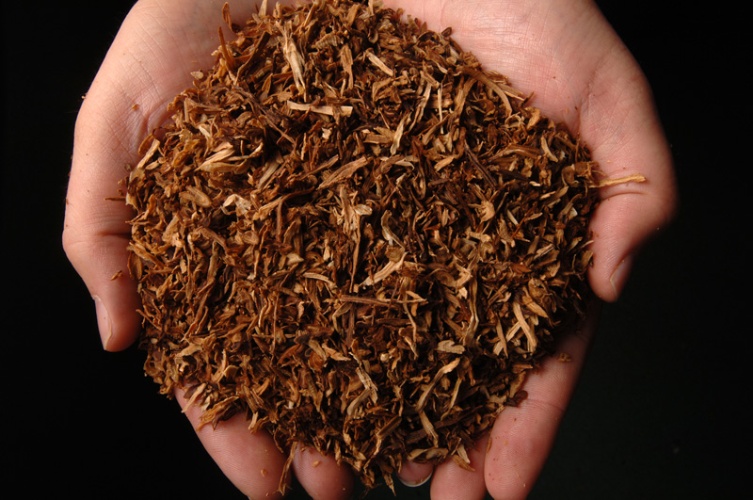 How do you begin creating a new blend? (What is your working method?) Is it for example so that you have an idea, or are you maybe inspired by a certain kind of leaf a tobacco manufacturer has?
How do you begin creating a new blend? (What is your working method?) Is it for example so that you have an idea, or are you maybe inspired by a certain kind of leaf a tobacco manufacturer has?
I do not know if there is a general procedure for the blending of tobaccos. For me, the mixtures are created in my imagination. In the beginning the idea is what type of tobacco I would like to create. And I am often inspired by the mixtures I smoke or have smoked in the past. To begin with this is enough, in the meantime I have to make up my mind whether such a tobacco is useful for my shop.
Then I think about how a tobacco should taste, what is the cut I will use by the production of the end product and of course how or with what tobaccos I can reach the goal I set. This often goes on for weeks and then I have very clear picture of what I want to do and what components I can achieve this. It is important, of course, to have exact knowledge of the available mixing tobaccos. Otherwise this method does not work and one has to carefully reach the end goal with sample mixtures.
Please describe the whole process from having an idea for a tobacco to the final end-product, tinned and ready.
The practical work begins with the sample mixtures. Most are 2-3 ideas of each 20 gr., the smallest amount, that I mix myself. This is the right amount to first detect whether you are on the right path or are totally wrong. Most of the times the direction in which you are heading is correct, sometimes you score a direct hit, but often it is also completely wrong.
I pack the samples into tobacco tins and let them rest for at least 1 week.
After that we smoke the samples while writing down corresponding records or observations. I also always directly scribble down with which new varieties of tobacco, or changes in the mixing ratio, I think I can improve the result. Of course changes are not immediately made, before that happens I have smoked 2-3 pipes of the respective sample and also express my thoughts on paper.
Then I make new samples of the changed recipes. Normally I then make 50 gr. samples and let other people trial-smoke those. Often some small changes have to be made and in the most ideal case I already have a finished mixture.
Now I go to the manufacturer and let create a 100 gr. sample of my recipe. Again it often comes here to minor differences in the taste. I correct those with another recipe change and if necessary, a 100 gr. sample is once again created by the manufacturer.
If everything fits I have done my share of the work, the price of the mixture can be calculated and can then be produced.
At the same time as the making of the mixture the labels are being created. Now this is of course no longer as expensive as in the beginning, because the different brands are already available and it just has a new name and a corresponding description of the tobaccos used. In the United Passion flakes a new image will be added to the existing lay-out. The finished labels are then printed and sent to the manufacturer so I’m getting tins that are already labelled.
In broad terms this is how the HU Tobacco tobaccos come into existence.
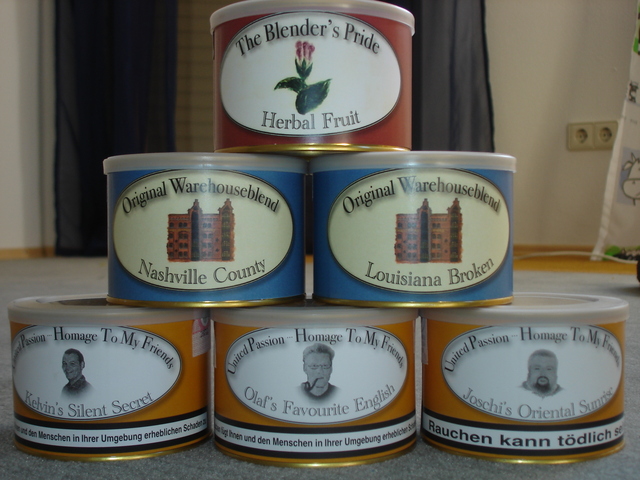 In short, how did your tobacco-lines came into existence?
In short, how did your tobacco-lines came into existence?
• The Blender’s Pride
• Foundation by Musico
• United Passion
• Original Warehouse Blend
• United Passion Flakes
• United Passion Special Blends
I started with the lines of United Passion, The Blender’s Pride and Original Warehouse Blend. The names of the various product lines emphasize the flavour orientation of the blends. The Warehouse Blend series includes mixtures of a very high level but without flavouring, so rather purist approach. I find the term Warehouse Blend symbolizes the direction quite well. No fancy tins, no flavours, just blends without frills.
Unlike the Blender’s Pride series.. Here it is more or less about subtly flavoured mixtures. A less purist approach, but not completely over the top. The tobaccos are of the same quality as the Warehouse blends, so we are talking about very high quality aromatics. This is what I want to say about the Blender’s Pride. Also, the flourishing tobacco plant on the label stands for honest but flowery tobacco.
With United Passion the idea was to tobacco mixtures for my closest friends. Here the flavour spectrum ranges from pure natural to floral and soapy, but in any case always individual, according to the taste of my friends. I found the term “United Passion” with the addition Homage To My Friends very fitting.
That was the initial situation. In the meantime the United Passion Flake series was added. As with the “Homage To My Friends tobaccos” the flakes are being produced by DTM. Hence the name United Passion Flakes.
About Foundation by Musico I do not need to say much. It is a collaboration with Massimo Musico and, in the interests of both parties bear the name of the pipes produced by Massimo. The series is clearly latakia-orientated and of very high quality. So each series has a distinct direction and I personally find that very beautiful.
 What are your favourite HU Tobacco blends? On which ones are you most proud?
What are your favourite HU Tobacco blends? On which ones are you most proud?
Hmm.. This is a very difficult question. Of course, I like all my tobaccos, the one more, the other less. But all tobaccos wear my handwriting and thus are created by my imagination. A great pleasure at that time was the creation of Old Fredder’s Broken Flake. It is simply a well-balanced mixture, with all the facets that can provide a good Va / per blend. It is actually a rather old-fashioned mixture without any gimmickry or sensationalism. Old Fredder’s is simply what it is, a great tobacco, no more but also no less. And that is what I like about the mixture and what makes it so endearing to me. This tobacco often stands in the shadow of other mixtures, but has conquered a very loyal following in the meantime. It is similar with “My Special One“. A mixture of bygone days. When I open the can, it emanates a scent that you can smell in “old” tobacco shops. I’m not talking about posh, modern shops, but of shops where the cigar boxes are stacked chaotically, there is a lot of smoking inside and where the walls give away the tobacco smell of past years. My Special One is a thoroughly honest, straightforward blend. You know what you get involved with. This tobacco is not a revolution, it is like a homage to bygone days.
But I’m not a dreamer, and I am not very creative when I just wanted to convey the flavour of the old days. The Foundation tobaccos are going exactly the opposite way. Here we have a very modern direction. With the Khoisaan I present a practical tobacco that only consists of condimental tobaccos. Besides the Tuarekh these English blends only have a very small proportion of orientals. Anything but classical. I can not go into every single blend, but I think you realize that I am very proud of all mixtures. Each blend has its peculiar characteristics and came into existence very consciously. Besides, I’m just a very emotional person and I connect tastes with experiences. Arno, I can not completely answer the question, but I think you know what I mean.
What are your favourite non-HU Tobacco blends?
Oh, there are some blends that I find absolutely fantastic and I always like to smoke. I really like the Lakeland tobaccos and in particular the (Samuel Gawith) Full Virginia plug and Best Brown Flake. I think of Squadron Leader as a very good “English” but within the genre I would rather go for Cornell & Diehl Byzantium or GL Pease Lagonda. If it is time to be subtle, Erinmore Balkan Mixture can also make me very happy. From Russ Ouellette I like Louisiana Red and Frenchy’s Sunza Bitches very, very much. I could go on much more about the varieties I mentioned that I really like, but of non-HU Tobacco tobaccos this is what I like to smoke.
This interview continues in part 3.
You can buy Hans’ excellent tobaccos here.
Interview with master-blender Hans Wiedemann from HU Tobacco – Part 1.
Once there was a time that I was petrified that my few “tobacco-lines” with the USA became distorted. How could I live my pipe-smoking life without excellent tobaccos like Abingdon, Lagonda, Westminster, Escudo, Balkan Supreme and many others? In The Netherlands there are few tobaccos of my liking. Then I got introduced by fellow Dutch/Belgian pipesmoker forum member “Smokin'” Rob to the tobaccos of German master-blender Hans Wiedemann from HU Tobacco. Hmzz… Those blends can never be as good as the ones from the States, I silently thought. But being the curious fellow that I am I decided to ask Hans if he also sold samples of his mixtures. And he did. I smoked them and wowww… I could not believe how good they were! On par or even better than many tobaccos available in the USA. So I immediately ordered a bunch of tins and got into contact with Hans more and more. He is such a warm, friendly and modest guy with a big heart. That showed because after I thought the whole forum-tobacco quest ended he extended his helping hand and saved the entire project. Hans also was willing to answer questions for an interview for my blog. Here it is:
 How long have you been smoking pipe?
How long have you been smoking pipe?
I have been smoking pipe since I was 15. Of course not as intensive as in later years. As a teenager you have other things on your mind and you often miss the moment of rest for the enjoyment. But since that time the pipe always accompanied me and it never lost its fascination for me. The nice thing about pipe smoking is simply the connection of a beautiful smoking device with a wide range of tobaccos with all kinds of tastes. A pipe which smokes excellent and also looks great is almost like a friend for life. This is one of the reasons why I stick to the pipe and prefer it over the cigar. All other enjoyments of smoke are too fast paced and a good cigar simply goes up in smoke, and provides no lasting value for the connoisseur.
What are your favourite pipe shapes and why?
Concerning pipe shapes I am more conservative then with my choice of tobaccos. I feel a connection with classic pipe shapes in which you can recognize the personal style of the maker. Revolutionary shapes, or in other words crazy, spectacular shapes are not my taste. The classic shapes have proven themselves particularly through their smoking properties and are still exciting for me. I take off my hat to every pipe maker who goes to the limits of a shape without blurring the original form. There the art lies in the details.
My favourite shapes since long are the Dublin, Pot, Bulldog, Prince and Cutty. These shapes are really created very differently. The pot and Bulldog are rather strong, burly pipe shapes while the Cutty, Dublin and Prince are sometimes interpreted as very delicate. I love the contrasts and depending on the mood of the day and the preference for a tobacco I choose a delicate or a more robust pipe. Classic does not have to be dusty, classic can still be very exciting.
Do you have a favourite genre of tobacco that you like to smoke?
Of course I have certain tobacco genres which accompany me since long and to where I return again and again despite all kinds of sidesteps. My great loves are the Virginia / Perique blends and to-the-point English blends. I think this you can clearly see this in my supply of tobacco. Again and again I turn to the Burley-mixtures, but they can never conquer my heart forever. But these are always mixtures that excite me and therefore are a great change to my “favourites”.
I sometimes like to smoke aromatic tobaccos but my interpretation of the term aromatic is unlike most others. Aromatic tobaccos should assist only the tobacco taste with their casing, maybe put some little accents, but the tobacco base should never be “destroyed”. This is not a widely accepted view, but the interpretations of the aromatic tobaccos blended by me have a very loyal following. Perhaps this is because this niche is only partially covered by other manufacturers and it offers tobacco flavour nuances that heavy aromatized tobaccos just do not offer these days.
But coming back to my personal passions, the Virginia / Perique and Latakia mixtures, is there anything more honest than the natural blends of these genres? Do you not find the ethereal taste of a good Latakia different every day? Do you not always taste nuances that you have never tasted before, or simply perceived differently? These aspects breathe the life in the enjoyment of pipe tobacco and that falls away when a tobacco is heavily aromatized.
 How did you acquire all of your tobacco knowledge? In the early days internet was not there yet. Books?
How did you acquire all of your tobacco knowledge? In the early days internet was not there yet. Books?
Yes, with internet really a new era dawned and the ways that you can gather knowledge can be described as wonderful. But to the surprise of many, I am not a tobacco-guru. My modest knowledge of tobacco is not theoretical, but is a result of many conversations with experienced pipe smokers and the visits I undertook in the 90’s to Dan Tobacco. Of course, I devoured all the standard readings of pipe smoking. But like I said, in the smoking community by comparative tests and discussions you learn how oriental tobaccos taste or how the addition of burley affects a Latakia mixture. Those are practical things that one can only learn so far by pure theory.
And honestly it is more fun to gather your own experiences than googling for hours. Like I said, my focus is less on theoretical knowledge and more on “practical experience”.
Why did you started blending tobaccos? Were you for example unsatisfied with available mixtures?
Hmm…. That’s a long story. The basic idea was born at the Lohmar Pipeshow 2010. Along with Kelvin, name-giver of my tobacco “Kelvin’s Silent Secret“, the idea was born to try import interesting tobaccos from abroad. It always annoyed the both of us that mixtures from abroad cost a lot and were very hard to obtain. But after a little research I understood that it was not possible to realize this idea. To import tobaccos, apart from a desire to do a lot of paperwork, you need a lot of money and a high level tolerance of risk. All this was not what I was looking for, after all it was supposed to be just a hobby. Besides my day job I also have a wife and 3 small children. So the idea came to create tobaccos according to my own visions and sell them through an online store. Since Kelvin was in a completely different phase of life than me and focused himself on starting a family, he let me go first, and concentrated on the pipe making. That way the idea was born, not knowing what was coming.
When you first started blending pipe tobacco blends, was it more of a hobby or did you already had plans to make it into a business?
As long as I can remember I was always searching for the best tobacco. Sometimes this was not always pleasant, because a certain restlessness is in it, but you also learn about an awful lot of different tobacco blends. I always had the desire to unite all the advantages of different tobacco species in a mixture. Ok, that is impossible, but this thought prompted me to create my own blends over and over again. So I have some experience with home-mixing before HU Tobacco. Many ended up in the garbage because they were not useful or simply not good enough to really have fun with. But over time by adding the right ingredients you get a feel for the direction in which a mixture is going to develop. So before before I decided the venture into the world of tobacco-mixing and present blends to the public, I had the phase of beginner-mistakes behind me.
Do you have a favourite type of tobacco when blending?
I can’t really say that. I have 2 to 3 great Virginias available to me that I really love working with and that I have often used lately. But this should not be the standard, otherwise the mixtures are simply becoming too similar. Yes I want to show the whole range of individual types of tobacco in my mixtures. Otherwise it would make no sense to offer several Virginia or Virginia / Perique blends. In my recent creations, I tried to put tobaccos in the foreground which lead a shadowy existence at the large manufacturers. Especially Kentucky, Burley and Oriental tobaccos. Because of this tobacco combinations came into existence that not or almost not existed in Europe to date. Burley / Orient, Orient / Kentucky, Burley / Perique to name just a few examples.
I would like to re-phrase the initial question: Are there tobacco genres you prefer to blend? The answer to this question would for me be an unmistakable yes. Latakia mixtures are the most exciting for me as a blender because this genre offers the biggest “playground”.
How did HU Tobacco came into existence?
How I came to the idea, I’ve already answered. But of course there still was a long way to go before the founding of HU Tobacco. I first had to find partners who were willing to manufacture my mixtures. Because my sales are ridiculous compared to the major manufacturers, I did not encounter mutual love everywhere.. Sometimes the targets had been set very high which of course brought many sleepless nights. Not knowing how everything was going to develop, I took a few risks and registered my company at the authorities.
This interview continues in part 2 and part3.
You can buy Hans’ excellent tobaccos here.
Smokin’ Easter
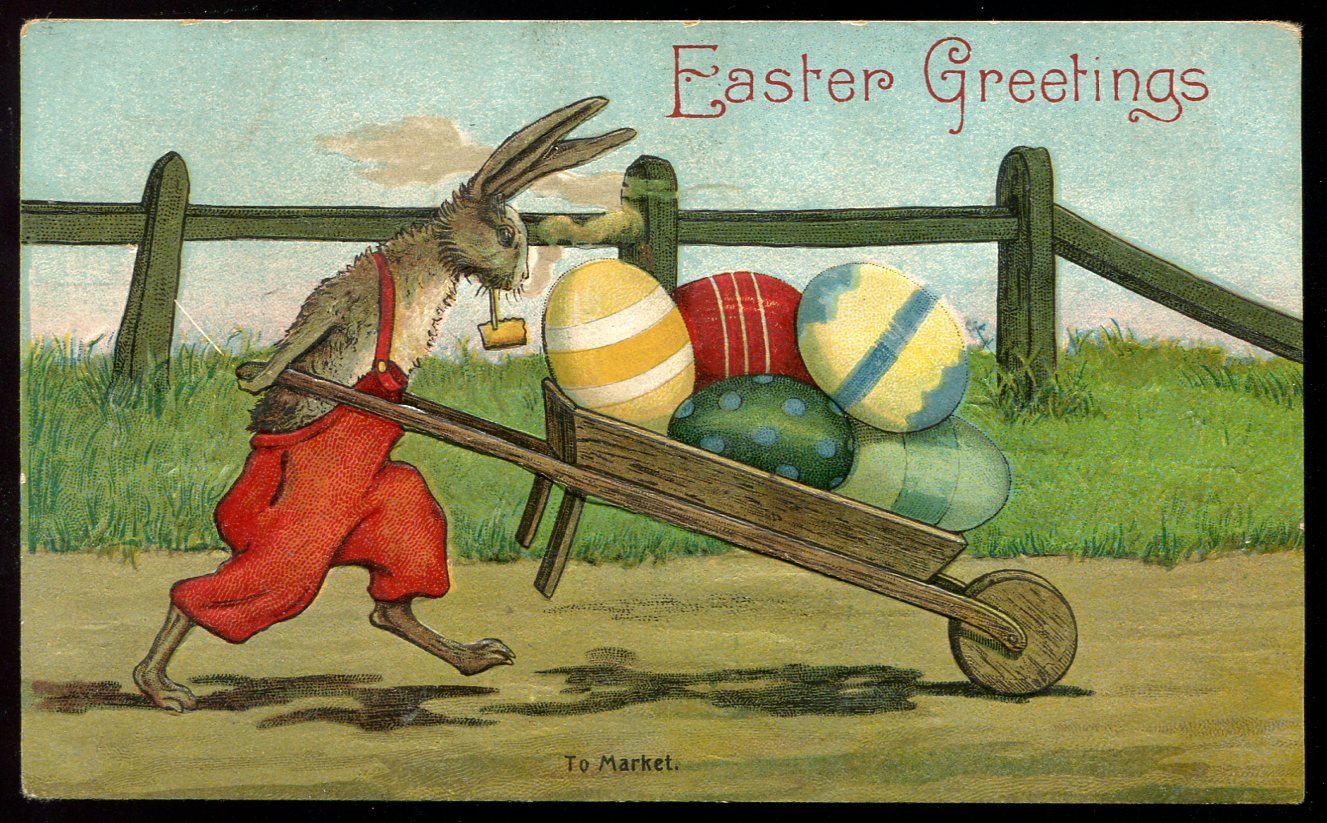 When I look around the living room I see a lot of Easter paraphernalia.. Wooden eggs, candle-eggs, bunny-miniatures, chick miniatures etc. In short, my girlfriend loves to decorate the house because it is almost Easter. I just like to sit and relax in my chair while smoking. I don’t have much up with religion and holidays, except for the days off of course. But I like the tradition, the history.
When I look around the living room I see a lot of Easter paraphernalia.. Wooden eggs, candle-eggs, bunny-miniatures, chick miniatures etc. In short, my girlfriend loves to decorate the house because it is almost Easter. I just like to sit and relax in my chair while smoking. I don’t have much up with religion and holidays, except for the days off of course. But I like the tradition, the history.
The ancient Saxons celebrated the return of spring with a festival in which they commemorated their goddess of offspring and springtime: Eastre (or Ēostre / Ostara). In the 2nd century Christian missionaries encountered the tribes of the north with their pagan celebrations. In a clandestine manner they attempted to convert them to Christianity.
It would have been suicide for the very early Christian converts to celebrate their holy days with disregard to the celebrations that already existed. To save lives the missionaries cleverly decided to spread their religious message slowly throughout the populations. They allowed them to continue celebrating pagan feasts, only in a Christian manner.
The pagan festival of Eastre occurred at the same time of year as the Christian resurrection of Christ. So it made sense to alter the festival itself by making it a Christian celebration. This way converts were slowly won over. The early name, Eastre, was eventually changed to its modern spelling: Easter.
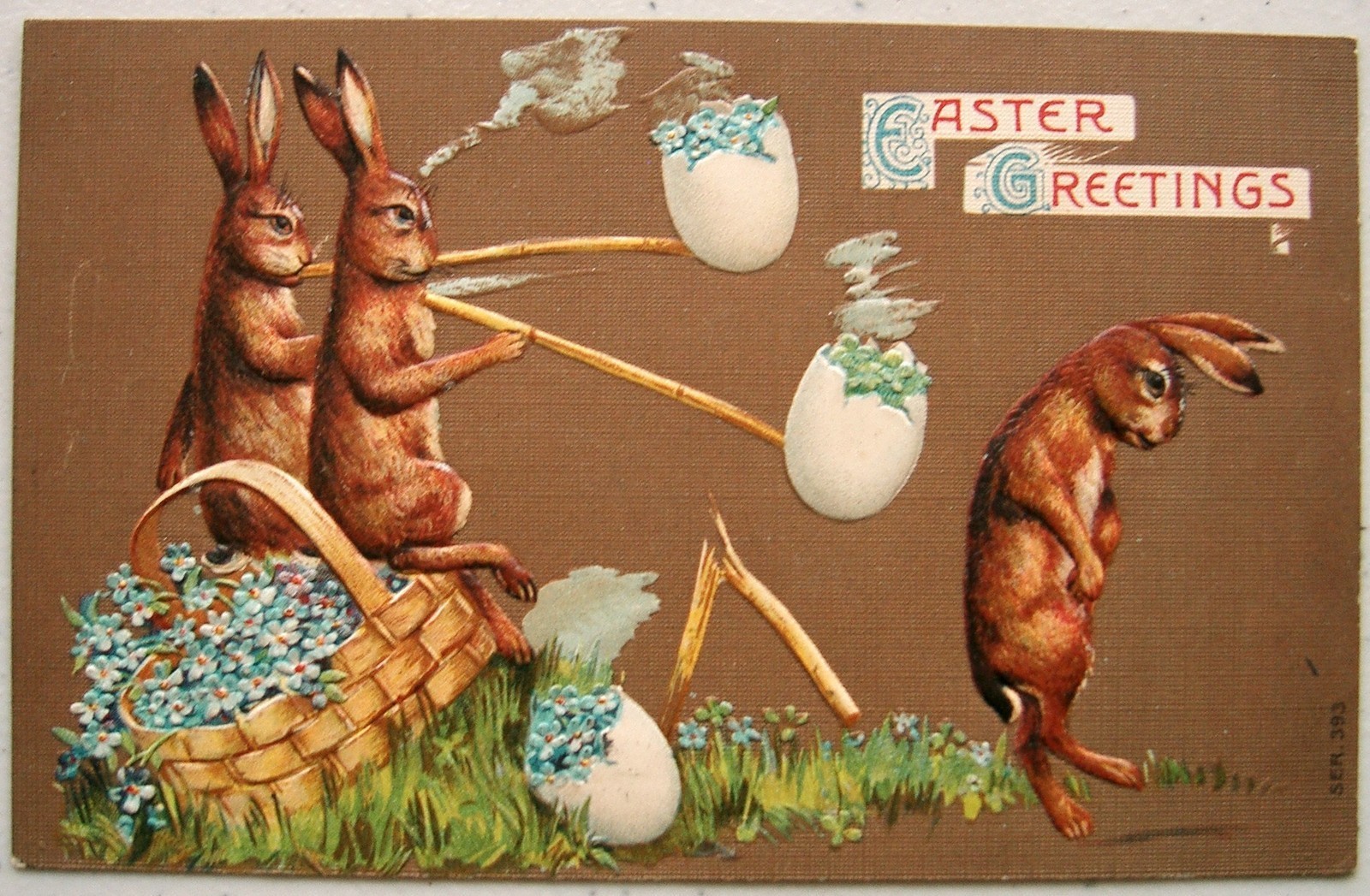 Today Easter exists of several days of which these are the most important:
Today Easter exists of several days of which these are the most important:
– Palm Sunday: The Sunday before Easter Day. It is to commemorate the last journey of Jesus to Jerusalem. People then cut palm branches to spread on his path as he rode to the city.
– Holy Thursday: Here in Europe Christian monarchs used to wash the feet of poor people on the Thursday before Easter. This in memory of Jesus’ act. The new pope Francis breathed new life in this tradition. Also on this day Jesus ate and drank with his followers. This meal became known as the Last Supper, because Jesus died soon after.
– Good Friday: The commemoration of the trial and crucifixion of Jesus. I can remember eating meat was not allowed by my parents on this day. So we just had fish or bread.
– Holy Saturday: Part of the mourning period which begins on Good Friday. Also a day of cooking and preparing for the feasting the following day to celebrate the resurrection.
– Easter Day: The commemoration of the resurrection of Jesus. Of course a symbol of that is the egg out of which a bird hatches. And a lot of eggs are eaten during the feast that day.
– Easter Monday: The ideal day to get up late and relax. Here in Holland a lot of people go to furniture mega-stores which are open.
– Ascension: The 40th day from Easter day on which Jesus ascended into heaven.
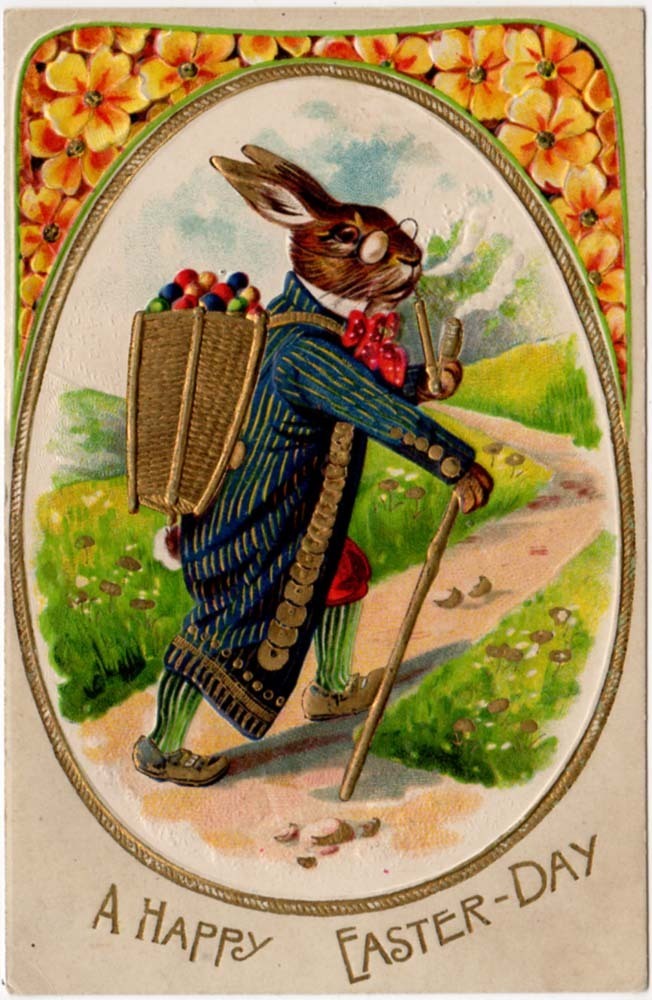 The Easter bunny is not some modern invention. The goddess Eastre (see above) was worshipped through her earthly symbol: the rabbit. The hare and the rabbit were the most fertile animals known and they served as symbols of the new life during the spring season.
The Easter bunny is not some modern invention. The goddess Eastre (see above) was worshipped through her earthly symbol: the rabbit. The hare and the rabbit were the most fertile animals known and they served as symbols of the new life during the spring season.
The Germans brought the symbol of the Easter rabbit to America. The bunny as an Easter symbol seems to have its origins in Germany. It was first mentioned in German writings in the 1500’s. The first edible Easter bunnies were made in Germany during the early 1800’s. Not of chocolate but of pastry and sugar.
German settlers believed that a white hare would leave brightly coloured eggs for all good children on Easter morning. So early American children built nests of leaves and sticks in their gardens. This way the Easter hare could fill it with coloured eggs. By the 19th century the Easter hare had become the Easter bunny. Children were spoiled with baskets of eggs, chocolates, candy chicks, jelly beans and other gifts on Easter morning. By the way, originally Easter eggs were painted with bright colours to represent the sunlight of spring.
Here in Holland Easter Day is known as “Paas-zondag” and there is a special Easter meal. Often the table is decorated with coloured eggs and so called “Paasbrood”, which is a sweet bread with raisins. In my youth my parents also hid chocolate eggs throughout the house. I had to search them and when I got near a hidden egg my parents would say “hot!” When there was no egg where I was searching they said “cold!” Needless to say that in my later years I knew all the secret hiding spots.
Nowadays I live in the east of the Netherlands where almost every village lights an Easter bonfire on some grass-land. People begin collecting wood for the fires weeks in advance. Often that wood exists of old Christmas trees. Of course each village tries to outdo the others by building a bigger and better fire than its neighbours.
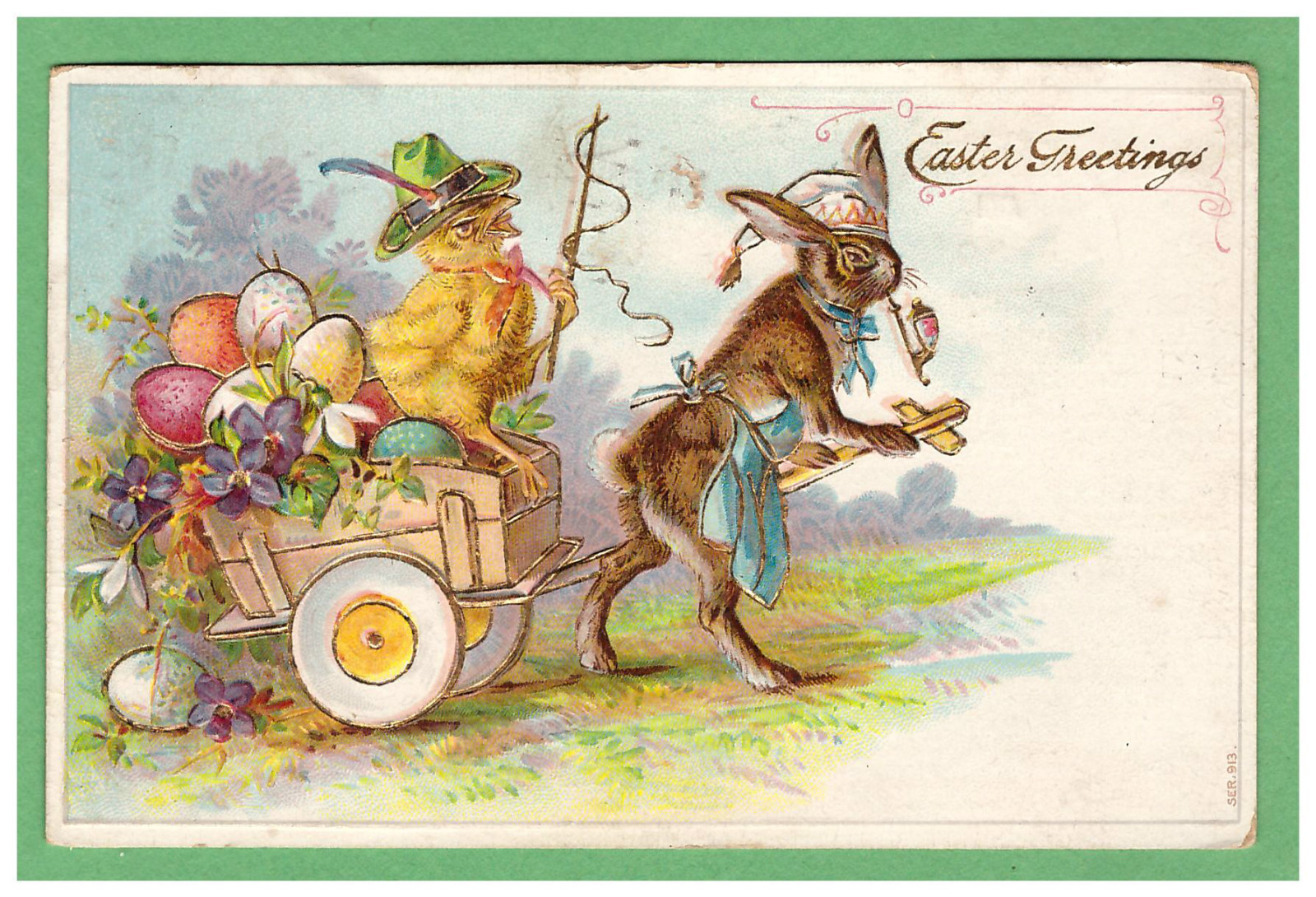 Last but not least; where does the pipe smoking bunny comes from that is depicted on many old postcards? Simple: Anthropomorphism. Say what?? Anthropo- morphism is the attribution of uniquely human characteristics to non-human animals or objects. Rabbits on Easter greeting postcards were often given human characteristics such as being portrayed as wearing clothing and smoking pipes.
Last but not least; where does the pipe smoking bunny comes from that is depicted on many old postcards? Simple: Anthropomorphism. Say what?? Anthropo- morphism is the attribution of uniquely human characteristics to non-human animals or objects. Rabbits on Easter greeting postcards were often given human characteristics such as being portrayed as wearing clothing and smoking pipes.
So relax, smoke a pipe and have a good meal. Happy Easter!













